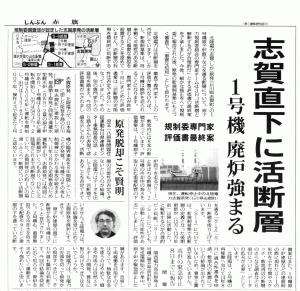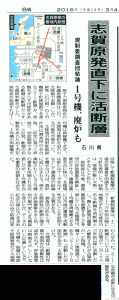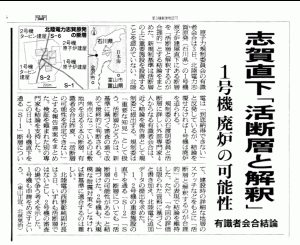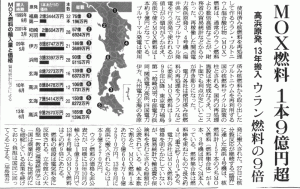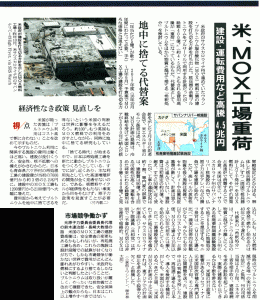Original Japanese written by staffer
The English below written and arranged by Heeday, based on the original Japanese
The English edited by Rev. Dr. Henry French, ELCA
Articles from the March 4th, 2016 editions of the Asahi Shimbun, Fukushima Minpo, and Akahata newspapers
▼Click each image to read an English summary of the Japanese article.
Faulty faults
Japan’s Nuclear Regulation Authority’s Survey Team of Experts has concluded that “the geological fault right under Unit 1 of Hokuriku Electric Power’s Shika Nuclear Power Plan (NPP) should rationally be considered as an active fault.” Last summer, the team’s draft decision said that the possibility of it being active could not be ruled out. Thus, the team’s final decision has been made.
In the coming months, the Authority’s examination meetings should discuss the decommissioning of Shika’s Unit 1. The Survey Team’s decision is to be treated as “an important expert opinion” and, unless Hokuriku Electric Power disproves it with sufficient new data, Unit 1 should be decommissioned.
Right below the NPP —
Especially problematic are three geological faults on the premises. Fault S-1, which runs right under Unit 1, has finally been determined to be an “active fault that can possibly move the ground.” As for the other two, named S-2 and S-6, which run right under the turbine buildings of Units 1 and 2, the Team determined that “though their gaps do not reach the surface, there is a possibility that they were active some 120,000 to 13,000 years ago.”
And faulty examinations
The Nuclear Regulation Authority (NRA) has been examining the sites of six NPPs, which its predecessor, the Nuclear and Industrial Safety Agency of the Ministry of Economy, Trade and Industry, asked it to continue, with expert examination of the active faults existing on the NPP premises. The NRA pointed out that one or more active faults could exist on the premises of Shika’s Units 1 and 2, Unit 2 of The Japan Atomic Power Company’s Tsuruga NPP, and Unit 1 of Tohoku Electric Power’s Higashidori NPP. These problems should have been discovered before those NPPs were built. We can naturally assume that the pre-construction examinations were faulty.
The safety examinations of Shika’s Unit 1 were conducted in 1987 and 1988, by the former Ministry of International Trade and Industry and the former Nuclear Safety Commission. Hokuriku Electric Power then conducted its own additional examination for geological faults. The Survey Team used drawings prepared by that additional examination to detect active faults. Some sections of the survey showed a suspicion of active faults. This suspicion, however, seems to have been ignored. We can therefore question whether or not the safety examinations were conducted fairly and correctly. It is noteworthy that the former Nuclear and Industrial Safety Agency remained reluctant to verify the safety examination results.
| ~Comment by Dr. Kazuya Kodama, secretary general of “Genpatsu Mondai Jumin Undo Ishikawa-ken Renraku Center (Ishikawa Prefecture Communications Center, Citizens’ Anti-Nuke Movements)”~
This conclusion explicitly states that the faults in question can be active, and describes the Survey Team’s examination in detail. Hokuriku Electric cannot disprove the possibility of active faults, even if it provides more data. The power company has no other choice but to accept the conclusion and decommission its Shika NPP. The conclusion declared Unit 1 to be inoperable since it has an active fault right below it. Unit 2 has active faults as well, running below its turbine building and the piping that collects cooling water, two important facilities. Repairing them to restart the unit would be a waste of money. Instead, Hokuriku Electric would better spend its money and technologies on the development and spread of natural energies. Hokuriku Electric is advised to go nuclear-free, becoming the first company to do so among Japan’s nine power companies with a NPP. That is the wisest choice. I am determined to let the citizens of Ishikawa know the Survey Team’s conclusion in order to accelerate their call for NPP decommissioning. |
The Japanese author’s wish
Units 1 and 2 of the Shika NPP have been out of operation since shortly before the meltdown of TEPCO’s Fukushima Daiichi. So far, however, Hokuriku Electric has experienced no major problem in supplying power. Also, the company owns huge hydraulic power plants. Therefore, spending more money on the Shika NPP, whose restart is now very questionable, would be nothing but a waste of money.
I also hope the NRA will make correct and fair decisions based on scientific knowledge. If it allows a restart that ignores an active fault on the very premises of the NPP, the safety regulations of NPPs will be rendered meaningless.
| Shika NPP
This NPP was built by Hokuriku Electric Power in the town of Shika, Ishikawa Pref. (160 miles north of Nagoya), on the Noto Peninsula facing the Japan Sea. The NPP accommodates two boiling water reactors (BWRs), the type of reactors also employed in Fukushima Daiichi. Unit 1’s operation began in 1993, with an output of 540,000 kW, followed by Unit 2 in 2006, whose output was 1,358,000 kW. In 1999, Unit 1 experienced a critical accident caused by an operational error. The power company concealed it until 2007, when the accident was discovered. Even after that, at Unit 1 some accidents involving the control rods occurred. The whole NPP has been out of operation since a regular checkup in March 2011. This plant’s premises are surrounded by many active faults. One of them, named “Fukura Fault,” is around 1 km (0.6 mile) away from the NPP. The power company refused to admit that Fukura is active, until 2013. |

